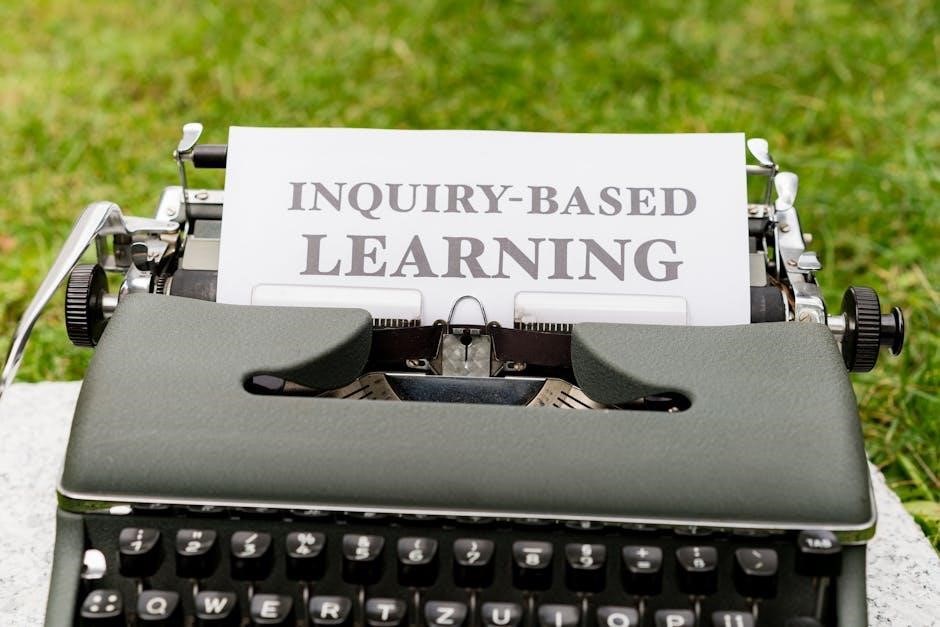Percentage word problems involve using percentages to solve real-world scenarios, a fundamental skill for Grade 7 students. Worksheets like those from Cuemath offer structured practice, helping students master calculations and applications through guided exercises and examples.
What Are Percentage Word Problems?
Percentage word problems are mathematical exercises that involve calculating percentages in real-world scenarios. These problems often require interpreting data, setting up equations, and applying percentage concepts to find solutions. For instance, they might ask for the percentage of a number, the percentage increase or decrease, or the calculation of discounts and taxes. Worksheets, such as those available from Cuemath or Success Tutoring, provide structured practice with examples like determining what percent 34 is of 100 or calculating the percentage of 7th graders on a basketball team. These exercises help students understand how percentages relate to fractions, decimals, and ratios, making them essential for developing problem-solving skills in mathematics.
Importance of Solving Percentage Word Problems for Grade 7 Students
Solving percentage word problems is crucial for Grade 7 students as it builds foundational math skills and prepares them for more complex concepts in higher grades. These problems enhance understanding of ratios, fractions, and decimals, which are essential for real-world applications like calculating discounts, taxes, and salary percentages. Worksheets, such as those from Cuemath or Success Tutoring, provide structured practice, helping students master percentage calculations through practical examples. By solving these problems, students develop critical thinking and problem-solving abilities, which are vital for academic success. Regular practice with worksheets also boosts confidence and fluency in applying mathematical concepts to everyday scenarios, ensuring a strong foundation for future learning.
Benefits of Using Worksheets for Practice
Using worksheets for practicing percentage word problems offers numerous benefits for Grade 7 students. Worksheets provide structured, focused exercises that help students build confidence and fluency in solving percentage-related tasks. They are especially useful for reinforcing concepts like converting percentages to decimals or fractions, calculating percentages of numbers, and understanding percentage increases or decreases. Worksheets such as those from Cuemath or Success Tutoring are designed to cater to different skill levels, offering a variety of problems that range from basic to advanced. Regular practice with these sheets improves problem-solving skills, enhances understanding of real-world applications like discounts and taxes, and helps students develop a systematic approach to tackling word problems. Additionally, worksheets serve as valuable tools for self-assessment, allowing students to track their progress and identify areas for further improvement.

Key Concepts and Basics
Mastering percentage basics is essential for solving word problems. Understanding percentages as fractions, converting them to decimals, and performing basic calculations are fundamental skills for Grade 7 students. Worksheets provide ample practice in these areas, ensuring a solid foundation for more complex problems. They also introduce concepts like calculating percentages of numbers, finding the percentage of two numbers, and understanding percentage changes, all of which are crucial for real-world applications. Regular practice with these worksheets helps students grasp these key concepts and build the confidence needed to tackle word problems effectively.
Understanding Percentages as Fractions or Ratios
Percentages can be expressed as fractions or ratios, making them easier to interpret. For example, 50% is equivalent to the fraction 1/2 or the ratio 1:2. This understanding helps students visualize percentages in different forms, enhancing their problem-solving skills. Many word problems involve converting percentages to fractions or ratios to simplify calculations. For instance, finding 15% of a number can be done by converting 15% to 0.15 or the fraction 15/100. Worksheets often include exercises that require students to interpret percentages as fractions or ratios, ensuring they grasp this fundamental concept. This skill is essential for solving real-world problems, such as calculating discounts or determining growth rates. By mastering percentages as fractions or ratios, students build a strong foundation for more complex percentage word problems in higher grades.
Converting Percentages to Decimals and Fractions
Converting percentages to decimals and fractions is a foundational skill for solving percentage word problems. To convert a percentage to a decimal, divide by 100. For example, 25% becomes 0.25. To convert a percentage to a fraction, place the percentage over 100 and simplify. For instance, 50% becomes 50/100, which simplifies to 1/2. These conversions are essential for calculations involving percentages, such as finding a percentage of a number or determining the original value before a percentage increase or decrease. Worksheets often include exercises that require students to practice these conversions, ensuring fluency in switching between forms. Mastery of this skill enhances problem-solving abilities and prepares students for more complex percentage applications in real-world scenarios. Regular practice with worksheets helps reinforce these critical mathematical concepts.
Basic Percentage Calculations
Basic percentage calculations involve fundamental operations such as finding a percentage of a number, calculating percentage increases or decreases, and determining percentages of whole numbers. For example, to find 15% of 200, multiply 200 by 0.15, resulting in 30. Similarly, to increase a number by 20%, multiply it by 1.20. Worksheets often include problems like these to build foundational skills. Understanding these calculations is crucial for solving real-world problems, such as calculating discounts, tips, or population growth. Grade 7 students benefit from practicing these concepts through structured exercises, ensuring they can apply percentages confidently. Regular practice with worksheets helps reinforce these essential mathematical skills, making complex problems more manageable in the future.

Common Types of Percentage Word Problems
Percentage word problems often involve calculating parts of wholes, comparing amounts, or determining increases/decreases. Common types include finding percentages of numbers, percentage comparisons, and real-world applications like discounts or taxes.
- Calculating a percentage of a number
- Finding the percentage of two numbers
- Percentage increase and decrease problems
- Discounts and tax calculations
Calculating a Percentage of a Number
Calculating a percentage of a number is a fundamental skill in percentage word problems. It involves finding a specific portion of a whole number based on the given percentage. For example, if a problem asks for 25% of 100, the calculation would be (25/100) * 100 = 25. Worksheets for grade 7 often include problems like “What is 15% of 200?” or “Find 30% of 50.” These exercises help students understand how percentages represent parts of a whole. The key formula to remember is:
Percentage of a Number = (Percentage/100) * Number
Grade 7 students benefit from practicing this concept as it builds their foundational math skills. Worksheets provide structured practice, ensuring mastery of this essential percentage operation before moving to more complex problems. Regular practice helps students apply this skill confidently in real-world scenarios, such as calculating discounts or percentages in sports statistics.
Finding the Percentage of Two Numbers
Finding the Percentage of Two Numbers
Finding the percentage of two numbers involves comparing a part of a number to the whole or comparing two numbers to determine their relationship as a percentage. For example, if a problem asks, “What percentage is 25 of 50?” the solution is (25/50) × 100 = 50%. This concept helps students understand ratios and proportions. Worksheets often include problems like “What percentage is 12 of 48?” or “What percent of 80 is 64?” These exercises enhance students’ ability to translate word problems into mathematical equations. The key formula to use is:
Percentage = (Part/Whole) × 100
Grade 7 students benefit from practicing this skill as it prepares them for more complex percentage applications. Worksheets provide ample opportunities to refine this essential math concept, ensuring a strong foundation for future problem-solving. Regular practice helps students apply this skill in real-world scenarios, such as calculating test scores or discounts.
Percentage Increase and Decrease Problems
Percentage increase and decrease problems involve calculating how much a quantity grows or diminishes by a certain percentage. For example, if a shirt originally costs $80 and its price increases by 15%, the new price is calculated as $80 + (15% of $80) = $92. Similarly, if the price decreases by 10%, the new price would be $80 ー (10% of $80) = $72. These problems help students understand how percentages affect quantities in real-life scenarios, such as discounts, taxes, or population growth.
The formula for percentage increase is:
New Value = Original Value + (Percentage Increase × Original Value)
And for percentage decrease:
New Value = Original Value ⎼ (Percentage Decrease × Original Value)
Worksheets with these problems allow students to practice applying percentages to various contexts, improving their problem-solving skills and mathematical reasoning. Regular practice ensures they grasp how percentages can represent changes in different situations, making them proficient in handling real-world financial and measurement challenges.
Discounts and Taxes
Discounts and taxes are common real-world applications of percentage word problems. Discounts involve reducing the original price by a certain percentage, while taxes add a percentage to the original price. For example, if a toy costs $50 and is on sale for 20% off, the discounted price is $50 ⎼ (20% of $50) = $40. Taxes, such as sales tax, are calculated by adding a percentage to the original price. If a book costs $30 and the sales tax rate is 8%, the total cost is $30 + (8% of $30) = $32.40. Worksheets often include scenarios like shopping, dining, or purchasing tickets, where students apply percentages to calculate final amounts. These problems help Grade 7 students understand how percentages affect daily financial transactions, preparing them for practical situations involving money management and budgeting. Regular practice with these problems builds confidence in handling real-world math challenges.
Real-World Applications of Percentages
Percentages are essential in everyday life, making them a vital skill for students to master. Understanding percentages helps in comparing quantities, measuring growth or decay, and making informed decisions. For instance, in finance, percentages are used to calculate interest rates, investment returns, and loan repayments. In sports, percentages can represent player performance, such as batting averages or success rates. Health and nutrition rely on percentages to understand calorie intake, medication dosages, and diet plans. Weather forecasts use percentages to predict probabilities of rain or sunshine; Even in shopping, percentages are used to calculate discounts, sales, and price comparisons. By practicing percentage word problems, Grade 7 students develop the ability to apply mathematical concepts to real-life scenarios, fostering problem-solving skills and financial literacy. Worksheets provide practical exercises to reinforce these applications, ensuring students are well-prepared for future challenges.

Advanced Percentage Word Problems
Advanced problems involve multi-step calculations, mixed operations, and multiple variables, requiring critical thinking and step-by-step solutions. These challenges help build analytical skills and prepare students for higher-level math.

Multi-Step Percentage Problems
Multi-step percentage problems require students to apply multiple mathematical operations and concepts to find the solution. These problems often involve calculating percentages in sequence, such as finding a percentage of a number after another percentage has been applied. For example, a problem might ask for the final price of an item after a 20% discount followed by a 10% tax. These problems help Grade 7 students develop critical thinking and problem-solving skills, as they must break down the problem into smaller, manageable steps. Worksheets designed for this purpose provide clear examples and guided exercises, allowing students to practice breaking down complex scenarios. By mastering multi-step problems, students build confidence in handling real-world financial and mathematical challenges, such as budgeting and calculating totals with discounts and taxes.
Percentages Involving Mixed Operations
Percentages involving mixed operations require the application of multiple arithmetic skills in a single problem. For instance, calculating a discounted price followed by adding tax involves subtraction and multiplication. A shirt originally priced at $80 with a 15% discount and then a 10% tax would first be reduced by $12 (15% of $80), resulting in $68, and then increased by $6.80 (10% tax), making the final price $74.80. These problems simulate real-life scenarios, such as budgeting and shopping, helping students apply mathematical concepts practically. Worksheets provide diverse contexts, like food delivery charges and discounts, to enhance understanding. Emphasizing the order of operations and providing guided solutions can prevent common errors, such as misapplying percentages or operations. Practice with varied scenarios and clear instructions aids in mastering these essential skills for future math challenges.
Word Problems with Multiple Variables
Word problems with multiple variables involve scenarios where more than one unknown or factor must be considered to find the solution. For example, a problem might ask for the original price of an item after successive discounts and taxes, requiring students to reverse-engineer the calculations. These problems enhance critical thinking and algebraic skills, as students must define variables, set up equations, and solve step-by-step. Worksheets often include real-world contexts, such as budgeting for school supplies or calculating total costs for events, to make learning engaging. Mixed-variable problems prepare students for advanced math by teaching them to break down complex situations into manageable parts. They also improve problem-solving strategies, encouraging students to verify their answers and ensure all variables are accounted for. Regular practice with these problems builds confidence and fluency in handling multi-step percentage calculations.

Solving Strategies for Percentage Word Problems
Effective strategies include setting up equations, using visual models, and checking answers for reasonableness to ensure accuracy and build confidence in solving percentage problems.
Setting Up Equations for Word Problems
Setting up equations is a cornerstone of solving percentage word problems. Begin by identifying the unknown and the given information. For example, if a problem states, “15% of 200 is what number?” translate it into an equation: 0.15 × 200 = x. Assign variables to unknowns and ensure the equation aligns with the problem’s context. Using percentages often involves converting them to decimals or fractions. Practice with worksheets helps Grade 7 students master this skill. Break down complex problems into smaller, manageable steps. For instance, in multi-step problems, solve for one variable at a time. Free PDF worksheets provide exercises that guide students through this process, reinforcing their ability to translate words into mathematical expressions accurately. This skill is essential for building a strong foundation in percentage problem-solving and real-world applications. Regular practice with such resources enhances problem-solving efficiency and confidence.
Using Visual Models and Diagrams
Visual models and diagrams are powerful tools for understanding percentage word problems. They help students visualize concepts like “part of a whole” or “comparison between quantities.” For instance, pie charts or bar graphs can illustrate percentages effectively. Grade 7 students can benefit from shading techniques to represent percentages in shapes or using number lines to show proportions. These models make abstract ideas more tangible and easier to grasp. Worksheets often include such diagrams, guiding students to break down problems into manageable parts. By coloring or marking sections, students can see how percentages relate to the whole. This method is especially helpful for multi-step problems, where visualizing each step enhances understanding. Free PDF worksheets offer a variety of these exercises, combining visual and numerical approaches. This dual strategy reinforces learning and builds confidence in solving percentage problems. Regular practice with these tools develops problem-solving skills and mathematical reasoning.
Checking Answers for Reasonableness
Checking answers for reasonableness is a crucial step in solving percentage word problems. Grade 7 students should learn to verify if their solutions make sense in the context of the problem. For example, if a problem involves a 20% increase, the result should be slightly higher than the original number. Worksheets often include exercises that encourage this practice. One effective method is to estimate before calculating. By rounding numbers, students can quickly determine if their final answer is in the right range. Another strategy is to use reverse operations. For instance, if a number is increased by 15%, dividing the result by 1.15 should return to the original number. Free PDF worksheets provide numerous problems where students can apply these techniques. Regular practice fosters a habit of critical thinking and helps students avoid careless errors. This skill is essential for building confidence and accuracy in solving percentage problems.

Resources for Grade 7 Students
Free PDF worksheets for percentage word problems are widely available online, offering targeted practice for Grade 7 students. Educational websites and math portals provide downloadable resources.
Free PDF Worksheets Available Online
Grade 7 students can access a variety of free PDF worksheets specifically designed for percentage word problems. These resources are available on educational websites, such as Math-Drills, K5 Learning, and others. Many worksheets are tailored to meet curriculum standards, ensuring relevance and effectiveness. They cover topics like calculating percentages of numbers, percentage increases and decreases, and applying percentages to real-world scenarios. Additionally, these PDFs are printable, making them convenient for independent practice at home or in the classroom. Some worksheets include answer keys, allowing students to self-check their work and identify areas for improvement. Teachers and parents can also use these resources to create structured lesson plans or homework assignments. Regular practice with these worksheets helps build confidence and mastery in solving percentage word problems. They are a valuable tool for reinforcing classroom learning and preparing for assessments.
Recommended Websites for Downloading Worksheets
Several websites offer high-quality percentage word problem worksheets for Grade 7 students. Math-Drills.com is a popular choice, providing an extensive library of free PDF worksheets tailored to various skill levels. K5Learning.com also offers a wide range of printable resources, including percentage word problems, designed to align with curriculum standards. Education.com features interactive and downloadable worksheets, along with detailed solutions to help students understand concepts better. Additionally, sites like WorksheetsWorks.com and SoftSchools.com provide customizable worksheets, allowing teachers to create specific exercises for their students. These platforms are user-friendly and offer convenient access to resources that cater to different learning needs. Regularly visiting these websites ensures access to updated and relevant materials for effective practice.
Practice Exercises
Grade 7 students can access various practice exercises online, focusing on percentage word problems. These exercises provide real-world scenarios to apply percentage concepts, ensuring a strong grasp of the topic.
Sample Word Problems with Solutions
Sample word problems with solutions are essential for helping Grade 7 students master percentage concepts. These examples provide clear, step-by-step guidance on how to approach and solve various percentage-related questions. For instance, a problem might ask, “What is 15% of 200?” The solution would demonstrate converting the percentage to a decimal (0.15) and multiplying it by 200 to get 30. Another example could involve calculating the discount on a $50 shirt that is 20% off, showing how to find 20% of $50 ($10) and subtract it from the original price ($40). These samples cover topics like finding percentages of numbers, calculating increases or decreases, and applying percentages to real-world scenarios such as taxes and discounts. By studying these problems, students can improve their understanding and build confidence in solving percentage word problems independently.

Worksheet Examples for Independent Practice
Worksheet examples for independent practice provide Grade 7 students with hands-on opportunities to apply their knowledge of percentage word problems. These worksheets typically include a variety of problems, such as calculating percentages of numbers, determining discounts, and solving for unknown values in percentage scenarios. For example, a worksheet might ask, “A shirt originally priced at $80 is on sale for 15% off. How much will you pay?” or “What is 25% of 320?” Many worksheets also include word problems involving multi-step calculations, such as tax calculations or percentage increases/decreases over time. Solutions are often provided at the end, allowing students to self-check their work and identify areas for improvement. These resources are widely available as downloadable PDFs, making them convenient for both teachers and students to use for practice at home or in the classroom.
Mastery of percentage word problems enhances problem-solving skills and real-world application abilities. Consistent practice with worksheets ensures confidence and proficiency in mathematical reasoning.
Summarizing Key Learnings
Grade 7 students can effectively master percentage word problems by understanding basic concepts, such as converting percentages to decimals or fractions. Practicing with worksheets helps build fluency in calculating percentages of numbers, percentage increases/decreases, and real-world applications like discounts and taxes. Students learn to set up equations, interpret results, and apply visual models for better comprehension. Regular practice fosters problem-solving skills, critical thinking, and confidence in tackling complex scenarios. Worksheets provide structured exercises to reinforce these skills, ensuring students are well-prepared for higher-level math. By focusing on step-by-step approaches and checking answers for reasonableness, students develop a strong foundation in percentage word problems, enabling them to apply these skills in various academic and practical situations.

Encouraging Continued Practice
Consistent practice is essential for mastering percentage word problems. Grade 7 students should regularly engage with worksheets to reinforce their understanding of percentages. By dedicating time each day to solve problems, they can gradually improve their speed and accuracy. Parents and educators can motivate students by celebrating small achievements and emphasizing the practical applications of percentages in real-life scenarios. Encouraging self-assessment and peer discussion fosters a deeper understanding and builds confidence. Accessing free PDF worksheets online provides students with ample resources to practice independently. Setting achievable goals, such as completing a set number of problems weekly, helps maintain momentum. Continued practice ensures that students not only retain what they’ve learned but also develop the ability to tackle more challenging problems with ease. This consistent effort will lay a strong foundation for their future academic success.

References
Recommended worksheets and tools include Khan Academy, Education.com, and Math Goodies, offering free PDF resources for grade 7 percentage word problems. These websites provide interactive and printable materials.
Recommended Worksheets and Tools
For effective practice, grade 7 students can utilize Khan Academy, Education.com, and Math Goodies, which offer free PDF worksheets on percentage word problems. These resources provide comprehensive exercises, including calculating percentages of numbers, percentage increases/decreases, and real-world applications. Additionally, Teachers Pay Teachers and Google Classroom feature customizable worksheets tailored to specific learning needs. Many of these tools include answer keys and step-by-step solutions, making them ideal for independent study. Parents and educators can also explore IXL and Math Drills for interactive and printable materials. These platforms ensure a well-rounded understanding of percentage concepts, catering to diverse learning styles and abilities. Regular practice with these worksheets will enhance problem-solving skills and build confidence in tackling complex percentage word problems.
